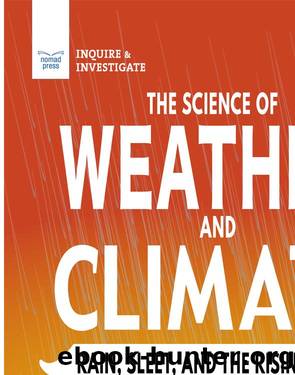The Science of Weather and Climate by Julie Danneberg

Author:Julie Danneberg
Language: eng
Format: epub
Publisher: Nomad Press
The Global Precipitation Measurement (GPM) Core Observatory tracks the globeâs weather from space.
credit: NASA
In Greek mythology, Zeus was the god of weather.
Weather forecasting is a complex task because weather is a complex system.
Todayâs meteorologists need to understand mathematics, physics, chemistry, computer programming, and more. Impressed? You should be! Forecasting the weather is an important job, and it has become more crucial and more important as time has gone by. Letâs go back and take a look at the early days of weather forecasting so we can better understand todayâs world of meteorology.
EARLY WEATHER FORECASTING
In ancient societies, weather was thought to be created by the gods in response to human behavior. Therefore, understanding the weather meant identifying the behavior most likely to make and keep the gods happy. The first weather forecasters were priests or holy men acting as human intermediaries with the gods. Their job was to help the members of their community to create rituals and promote behavior that made the gods content.
For example, the ancient Mayans offered human sacrifices to keep the gods happy, and therefore the weather good. Native Americans performed rain dances. And in Greek mythology, the forces of nature were explained by personifying elements of the weather as gods.
Although early human scientific knowledge might have been lacking, our knowledge of nature was not. A close relationship with nature yielded a wide range of information that was used to predict the weather. This information helped determine when to set sail and when to stay home, when to plant and harvest crops, and when to store food for the winter.
As the centuries passed, humans became more advanced in their understanding of the world. In 350 BCE, the Greek philosopher Aristotle (382â322 BCE) gathered together the most important scientific knowledge of the time in his four-volume text titled Meteorlogica. He shared theories about the formation of rain clouds, hail, wind, and thunder.
Although many of the ideas were wrong, some of Aristotleâs beliefs still hold true today, 2,400 years later! For instance, he believed that the sun put large masses of air into motion (it does) and that water vapor was part of our air (it is).
It wasnât until the Renaissance Period (approximately 1300â1700 CE) that curiosity about the natural world, including the weather, prompted the invention of tools to measure its different elements.
Several of the instruments invented at that time are still in use.
For example, today, we take knowing the temperature for granted. Itâs pretty easy to glance at a thermometer hanging on a wall or even at a smartphone, if you have a temperature app. Before a version of the thermometer was invented in 1593 based on discoveries made by Galileo Galilei, peopleâs understanding of temperature was purely personal and experientialâthey stepped outside to see if it was hot or cold.
Other tools invented during the Renaissance include the first hygrometer, created in the mid-fifteenth century by Nicholas Cusa (1401â1464), a German scientist. The hygrometer measures the amount of humidity in the air. In 1643, Evangelista Torricelli invented the barometer to measure air pressure.
Download
This site does not store any files on its server. We only index and link to content provided by other sites. Please contact the content providers to delete copyright contents if any and email us, we'll remove relevant links or contents immediately.
Harry Potter: A Journey Through a History of Magic by British Library(378)
The Science of Philip Pullman's His Dark Materials by Mary Gribbin(361)
The Basics of Organic Chemistry by Clowes Martin;(353)
Harry Potter and the Sorcerer's Stone: SparkNotes Literature Guide by SparkNotes(319)
Flowers in the Gutter by K. R. Gaddy(287)
Braiding Sweetgrass for Young Adults by Robin Wall Kimmerer(284)
Super Simple Chemistry by D.K. Publishing(278)
Summary of the Selfish Gene by Readtrepreneur Publishing(277)
JavaScript Coding for Teens: A Beginner's Guide to Developing Websites and Games by Yueh Andrew(272)
Exam Success in Geography for IGCSE & O Level by Unknown(268)
Dark days in Salem: the witchcraft trials by Deborah Kent(256)
The Python Audio Cookbook;Recipes for Audio Scripting with Python by Alexandros Drymonitis(256)
Key Immigration Laws by Kathryn Ohnaka(246)
Analysis and Linear Algebra for Finance: Part II by Bookboon.com(245)
Cracking the AP Economics Macro & Micro Exams, 2017 Edition by Princeton Review(237)
Solutions for a Cleaner, Greener Planet: Environmental Chemistry by Marc Zimmer(232)
The Science of Fashion by Julie Danneberg;(224)
Reverse Engineering For Everyone! by mytechnotalent(222)
Cracking the AP Psychology Exam, 2017 Edition by Princeton Review(211)
